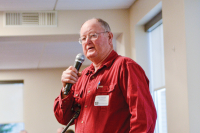If you suffer from hay fever, blame the ragweed
 Allergies are a type of immune reaction. Normally, the immune system responds to foreign microorganisms, or particles, like pollen or dust, by producing specific proteins, called antibodies, that are capable of binding to identifying molecules, or antigens, on the foreign particle. This reaction between antibody and antigen sets off a series of reactions designed to protect the body from infection. When this same series of reactions is triggered by harmless, everyday substances, it is called an allergy.
Allergies are a type of immune reaction. Normally, the immune system responds to foreign microorganisms, or particles, like pollen or dust, by producing specific proteins, called antibodies, that are capable of binding to identifying molecules, or antigens, on the foreign particle. This reaction between antibody and antigen sets off a series of reactions designed to protect the body from infection. When this same series of reactions is triggered by harmless, everyday substances, it is called an allergy.
— Encyclopaedia of Children’s Health
So, you find yourself coming down with the above symptoms? You’ve figured out that it’s hay fever you’re suffering from and have treated yourself acccordingly with the help of a physician or non-prescription drugs.
So far so good. But your next step is to get rid of the goldenrods along your drive or in a nearby field that your neighbor said are the cause of your misery.
You’ll be wasting your time. The pollen produced by goldenrod plants is far too heavy to get up into the air and land in your nose or eyes. Goldenrod pollen is so heavy that insects — especially bumblebees — are required to transport it from plant to plant.
Related Items
It’s the plants pollinated by windborne pollen that are the real culprits. And the most villianous plants in the hay fever world are the ragweeds. They bloom profusely along roadsides and in fields from late July into October, producing enormous quantities of microscopic pollen that randomly land on other ragweed plants or the bare ground or in your eyes and nose.
We have two ragweed species that are abundant as annual herbs: Common ragweed (Ambrosia artemisiifolia), which grows from one to six feet high, has opposite or alternate leaves that are divided into narrow segments. Great ragweed or buffaloweed (Ambrosia trifida), which grows from three to 15 feet high, has opposite leaves that usually display three to five lobes. The greenish flowers and seedpods appear in dense racemes at the ends of the upright stems.
So, now that you know it’s ragweed and not goldenrod causing your late-summer hay fever, the thing to do is to eliminate the stuff in your vicinity. Not possible. Ragweed is such a persistent and abundant plant you couldn’t exterminate it even with the assistance of the federal government. The pollen can travel for hundreds of miles in airstreams. Its seeds remain viable for up to five years, and they germinate readily whenever they find a patch of exposed soil.
Look on the bright side. Ragweed seeds, many of which cling to the plants through winter, provide food for birds during the most stressful portion of the year. Sparrows, purple finches, and other seed-eaters relish ragweed seeds and are, unknowingly, our most effective hay fever fighters.
George Ellison wrote the biographical introductions for the reissues of two Appalachian classics: Horace Kephart’s Our Southern Highlanders and James Mooney’s History, Myths, and Sacred Formulas of the Cherokees. In June 2005, a selection of his Back Then columns was published by The History Press in Charleston as Mountain Passages: Natural and Cultural History of Western North Carolina and the Great Smoky Mountains. Readers can contact him at P.O. Box 1262, Bryson City, N.C., 28713, or at This email address is being protected from spambots. You need JavaScript enabled to view it..









